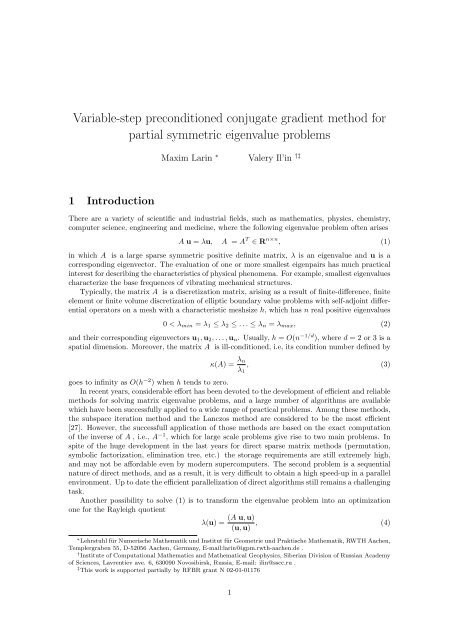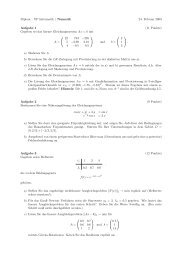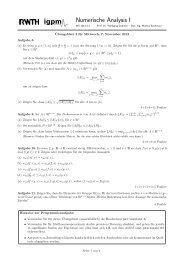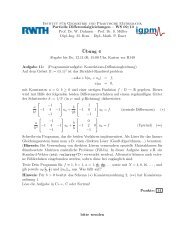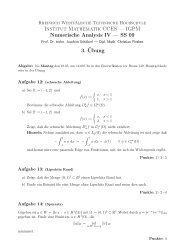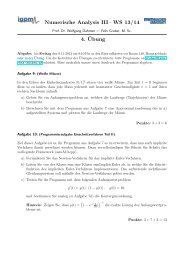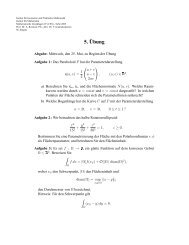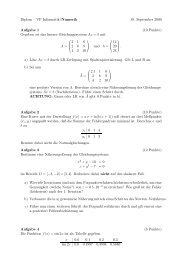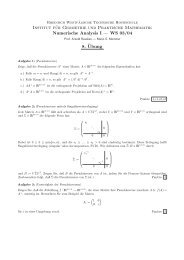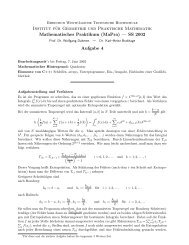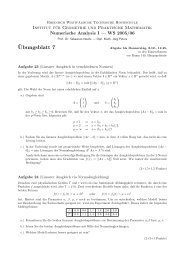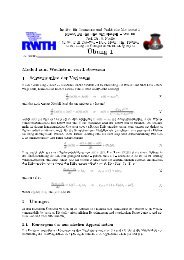Variable-step preconditioned conjugate gradient method for partial ...
Variable-step preconditioned conjugate gradient method for partial ...
Variable-step preconditioned conjugate gradient method for partial ...
Create successful ePaper yourself
Turn your PDF publications into a flip-book with our unique Google optimized e-Paper software.
<strong>Variable</strong>-<strong>step</strong> <strong>preconditioned</strong> <strong>conjugate</strong> <strong>gradient</strong> <strong>method</strong> <strong>for</strong><br />
<strong>partial</strong> symmetric eigenvalue problems<br />
1 Introduction<br />
Maxim Larin ∗ Valery Il’in †‡<br />
There are a variety of scientific and industrial fields, such as mathematics, physics, chemistry,<br />
computer science, engineering and medicine, where the following eigenvalue problem often arises<br />
A u = λu, A = A T ∈ R n×n , (1)<br />
in which A is a large sparse symmetric positive definite matrix, λ is an eigenvalue and u is a<br />
corresponding eigenvector. The evaluation of one or more smallest eigenpairs has much practical<br />
interest <strong>for</strong> describing the characteristics of physical phenomena. For example, smallest eigenvalues<br />
characterize the base frequences of vibrating mechanical structures.<br />
Typically, the matrix A is a discretization matrix, arising as a result of finite-difference, finite<br />
element or finite volume discretization of elliptic boundary value problems with self-adjoint differential<br />
operators on a mesh with a characteristic meshsize h, which has n real positive eigenvalues<br />
0 < λmin = λ1 ≤ λ2 ≤ . . . ≤ λn = λmax, (2)<br />
and their corresponding eigenvectors u1, u2, . . . , un. Usually, h = O(n −1/d ), where d = 2 or 3 is a<br />
spatial dimension. Moreover, the matrix A is ill-conditioned, i.e, its condition number defined by<br />
κ(A) = λn<br />
, (3)<br />
goes to infinity as O(h −2 ) when h tends to zero.<br />
In recent years, considerable ef<strong>for</strong>t has been devoted to the development of efficient and reliable<br />
<strong>method</strong>s <strong>for</strong> solving matrix eigenvalue problems, and a large number of algorithms are available<br />
which have been successfully applied to a wide range of practical problems. Among these <strong>method</strong>s,<br />
the subspace iteration <strong>method</strong> and the Lanczos <strong>method</strong> are considered to be the most efficient<br />
[27]. However, the successfull application of those <strong>method</strong>s are based on the exact computation<br />
of the inverse of A , i.e., A −1 , which <strong>for</strong> large scale problems give rise to two main problems. In<br />
spite of the huge development in the last years <strong>for</strong> direct sparse matrix <strong>method</strong>s (permutation,<br />
symbolic factorization, elimination tree, etc.) the storage requirements are still extremely high,<br />
and may not be af<strong>for</strong>dable even by modern supercomputers. The second problem is a sequential<br />
nature of direct <strong>method</strong>s, and as a result, it is very difficult to obtain a high speed-up in a parallel<br />
environment. Up to date the efficient parallelization of direct algorithms still remains a challenging<br />
task.<br />
Another possibility to solve (1) is to trans<strong>for</strong>m the eigenvalue problem into an optimization<br />
one <strong>for</strong> the Rayleigh quotient<br />
λ(u) =<br />
λ1<br />
(A u, u)<br />
, (4)<br />
(u, u)<br />
∗ Lehrstuhl für Numerische Mathematik und Institut für Geometrie und Praktische Mathematik, RWTH Aachen,<br />
Templergraben 55, D-52056 Aachen, Germany, E-mail:larin@igpm.rwth-aachen.de .<br />
† Institute of Computational Mathematics and Mathematical Geophysics, Siberian Division of Russian Academy<br />
of Sciences, Lavrentiev ave. 6, 630090 Novosibirsk, Russia, E-mail: ilin@sscc.ru .<br />
‡ This work is supported <strong>partial</strong>ly by RFBR grant N 02-01-01176<br />
1
the minimum of which λ(v) is equal to the smallest eigenvalue λ1 and the corresponding vector v<br />
coincides with the corresponding eigenvector u1. Here, (u, v) = uT v is the scalar product, which<br />
are induced the corresponding Euclidian norm �u� = (u, u) 1/2 .<br />
During the period 50’s to 70’s several <strong>gradient</strong> <strong>method</strong>s were suggested to find a smallest<br />
eigenpair based on minimization of the Rayleigh quotient along its <strong>gradient</strong><br />
∇λ(u) = 2<br />
(u, u) ·<br />
�<br />
�<br />
A u − λ(u)u . (5)<br />
The most attractive characteristic of these <strong>method</strong>s is that the iterative process requires only<br />
vector-vector and matrix-vector multiplications, which are highly suitable <strong>for</strong> being parallelized<br />
or vectorized. Moreover, these <strong>method</strong>s can easily handle large scale problems due to their much<br />
reduced storage requirements. Un<strong>for</strong>tunately, all of these <strong>method</strong>s suffer a very poor convergence<br />
properties <strong>for</strong> ill-conditioned matrices, since the rate of convergence of iterative optimization process<br />
depends on the ratio<br />
η = λ2 − λ1<br />
, (6)<br />
λn − λ1<br />
which is small because of large denominator, see <strong>for</strong> details [12, 13].<br />
On the other hand, there are a lot of efficient <strong>preconditioned</strong> iterative <strong>method</strong>s <strong>for</strong> solving the<br />
linear system of equations with discretization matrices. In particular, algebraic multigrid [32] and<br />
incomplete factorization <strong>method</strong>s [1, 7] allow us to construct optimal or nearly optimal <strong>method</strong>s,<br />
i.e., their rate of convergence does not depend on n or, the same, h and the total computational<br />
complexity is proportional to n.<br />
In the early 80’s it was proposed to use various preconditioning techniques to accelerate the<br />
convergence rate of the iterative minimization process <strong>for</strong> <strong>partial</strong> eigenvalue problem, see [4, 8] <strong>for</strong><br />
example. The complete survey and extensive bibiliography concerning <strong>preconditioned</strong> eigensolvers<br />
one can found in [12, 13]. The well-known two-term <strong>gradient</strong> <strong>method</strong> can be written as<br />
u (k+1) = u (k) − w (k) M (A u (k) − λ(u (k) )u (k) ), (7)<br />
where M is a preconditioner, which approximates the matrix A −1 , and w (k) is a scalar value<br />
computed either from minimization condition <strong>for</strong> the Rayleigh quotient (4) on the two-dimensional<br />
subspace spanned on last iterate u (k) and its <strong>gradient</strong> M (Au (k) −λ(u (k) )u (k) or defined as w (k) =<br />
1. However, the theoretical results given in these works was not so attractive as the corresponding<br />
numerical results, since the theoretical estimates of the rate of convergence was still based on (6).<br />
Recently Neymeyr [21, 22, 23] considered the <strong>preconditioned</strong> <strong>gradient</strong> <strong>method</strong> as the standard<br />
inverse iteration <strong>method</strong>, in which the linear system of equation<br />
was solved approximately by<br />
where the preconditioner M is such that<br />
A u (k+1) = λ(u (k) )u (k)<br />
u (k+1) = λ(u (k) )M u (k)<br />
�I − MA�A ≤ γ < 1. (10)<br />
Here �·�A denote the energy norm induced by the energy scalar product (u, v)A = (Au, v). Using<br />
the geometrical interpretation of the <strong>method</strong> he obtains the following sharp convergence estimate:<br />
if λ = λ(u (k) ) ∈ [λ1, λ2], then<br />
λ(u (k+1) ) ≤ λ1,2<br />
(11)<br />
where<br />
λ1,2 = λλ1λ2(λ1 + λ2 − λ) 2 �<br />
· γ2 (λ2 − λ)(λ − λ1)(λλ2 + λλ1 − λ2 1 − λ2 2)<br />
−2γ √ λ1λ2(λ2 − λ)(λ − λ1) � λ1λ2 + (1 − γ 2 )(λ2 − λ)(λ − λ1)<br />
−λ(λ1 + λ2 − λ)(λλ2 + λλ1 − λ 2 1 − λ1λ2 − λ 2 2)<br />
2<br />
� −1<br />
(8)<br />
(9)
which is too complicated <strong>for</strong> understanding main convergence-depended factors. Likely this sharp<br />
estimate has another representation, which has been done in [14] and which we will use here (see<br />
Theorem 3).<br />
It is well-known that the subspace iteration <strong>method</strong> <strong>for</strong> computing m smallest eigenpairs described<br />
in Section 3 is a straight<strong>for</strong>ward generalization of the inverse iteration <strong>method</strong> <strong>for</strong> the first<br />
eigenpair, from which the <strong>preconditioned</strong> subspace iteration version of the <strong>method</strong> is naturally<br />
followed. Un<strong>for</strong>tunately, the rate of convergence, given in [15], <strong>for</strong> the block version of the <strong>preconditioned</strong><br />
<strong>method</strong> does not depend on the number of vectors used as it is <strong>for</strong> the original subspace<br />
iteration <strong>method</strong> [27].<br />
In the present work we continue the study of optimal eigensolvers, which was began in [18], and<br />
define a variable-<strong>step</strong> preconditioning <strong>method</strong>s <strong>for</strong> solving the <strong>partial</strong> eigenvalue problem (1), see<br />
Section 4. In the role of the corresponding variable-<strong>step</strong> preconditioner we consider two different<br />
nonlinear solvers, see Section 5. The first one is based on the iterative incomplete factorization<br />
technique, whereas the second one is constructed by the algebraic multigrid <strong>method</strong> applied to the<br />
matrix A. The numerical results in Section 6 show that both <strong>method</strong>s are robust and efficient,<br />
but the algebraic multigrid <strong>method</strong> has naturally the better time per<strong>for</strong>mance due to its optimal<br />
nature <strong>for</strong> elliptic boundary value problems [31]. Some interesting remarks about the convergence<br />
behaviour of the <strong>preconditioned</strong> eigensolver are given in Appendix A and B. Finally, we compare<br />
our <strong>preconditioned</strong> <strong>gradient</strong> eigensolver with the direct multigrid eigensolver from [19, 20] and<br />
give some conclusions.<br />
2 Problem <strong>for</strong>mulation<br />
Consider the elliptic eigenvalue problem<br />
−<br />
d�<br />
i,j=1<br />
∂<br />
∂xi<br />
�<br />
aij(x) ∂<br />
∂xj<br />
�<br />
uk(x) = λkuk(x), x ∈ Ω,<br />
uk(x) = 0, x ∈ ∂Ω, k = 1, . . . , p,<br />
where Ω is a polygonal domain in R d with boundary ∂Ω, where d = 2 or 3 is a spatial dimension,<br />
the coefficient matrix [aij(x)] is assumed to be uni<strong>for</strong>mly symmetric positive definite <strong>for</strong> any x ∈ Ω<br />
and p is given integer.<br />
The Galerkin variational <strong>for</strong>mulation of the boundary value problem (12) is as follows.<br />
Find<br />
uk ∈ H 1 0 (Ω) = {v ∈ H 1 (Ω) : v = 0 on ∂Ω}<br />
such that<br />
a(uk, v) = λk(uk, v), k = 1, . . . , p,<br />
a(uk, ul) = δkl, l = 1, . . . , p,<br />
<strong>for</strong> all v ∈ H 1 0 (Ω), where δkl is the Kronecker symbol, the bilinear <strong>for</strong>m a(u, v) and the linear<br />
functional (f, v) are defined by<br />
⎡<br />
�<br />
a(u, v) = ⎣<br />
Ω<br />
2�<br />
aij(x) ∂u<br />
⎤<br />
�<br />
∂v<br />
⎦ dΩ, (u, v) = uv dΩ.<br />
∂xi ∂xj<br />
i,j=1<br />
Let us assume that the triangulation Υ of the domain Ω is such that the coefficient matrix<br />
[aij(x)] is constant in each element T ∈ Υ and can be discontinuous across the elements. Denoting<br />
by V ⊂ H 1 (Ω) the space of continuous functions, which are linear on each element from Υ, we<br />
obtain the <strong>partial</strong> eigenvalue problem<br />
A uk = λkuk, A = A T ∈ R n×n , 0 < λ1 ≤ λ2 ≤ . . . ≤ λp,<br />
(uk, ul) = δkl, k, l = 1, . . . , p ≪ n,<br />
3<br />
Ω<br />
(12)
where A is a global stiffness matrix, corresponding to standard piecewise linear functions in V ,<br />
which is calculated as<br />
A = {a(φi, φj)} n i,j=1,<br />
and {φi} n i=1 is a set of standard Lagrangian (nodal) basis functions in V .<br />
3 The subspace iteration<br />
One of the classical <strong>method</strong>s <strong>for</strong> computing the smallest eigenvalue and its eigenvector is the<br />
inverse iteration <strong>method</strong> [27], which generates a sequence of iterates v (i) by solving the linear<br />
system of equations<br />
Av (i+1) = v (i) . (13)<br />
In practice, the iterates are normalized after each <strong>step</strong>. Such subspace iteration algorithm can be<br />
described as follows.<br />
Algorithm SUBIT<br />
Input: m starting vectors v (0)<br />
1 , . . . , v(0) m<br />
Devices: to compute Av <strong>for</strong> a given vector v<br />
to compute the scalar product (v, u) <strong>for</strong> given vectors v and u<br />
to compute the Rayleigh-Ritz projection <strong>for</strong> a given subspace<br />
Method: <strong>for</strong> i = 0, 1, . . . , untill convergence<br />
<strong>for</strong> j = 1, . . . , m<br />
w (i+1)<br />
j<br />
= A −1 v (i)<br />
j<br />
end <strong>for</strong><br />
Apply<br />
�<br />
the Rayleigh-Ritz<br />
�<br />
<strong>method</strong> on the subspace<br />
Span<br />
w (i+1)<br />
1<br />
, . . . , w (i+1)<br />
m<br />
corresponds to the new Ritz vectors<br />
end <strong>for</strong><br />
Output: the approximations µ (i)<br />
j<br />
and set v (i+1)<br />
j , j = 1, . . . , m,<br />
and v(i)<br />
j to the smallest eigenvalues λj<br />
and corresponding eigenvectors uj, j = 1, . . . , m.<br />
Usually, one can simply extend any eigensolver <strong>for</strong> computing a single eigenpair to a subspace<br />
iteration in order to determine a number of eigenvalues and their corresponding eigenvectors.<br />
One can implement a subspace eigensolver by applying a given vector iteration to each vector<br />
of an actual eigenspace approximation. Subsequent application of the Rayleigh-Ritz projection<br />
computes the new eigenvalues and eigenvectors. The next theorems shows the classical convergence<br />
result <strong>for</strong> the subspace iteration.<br />
Theorem 1 [27] Let U = [u1, u2, . . . , um] be the matrix of wanted eigenvectors, and hence, U =<br />
span U is the dominant invariant subspace under A −1 . Let V be any m-dimensional subspace of R n<br />
and {A −i V : i = 0, 1, 2, . . .} the associated sequence generated by the subspace iteration. Moreover,<br />
we define the quantities ψ (i)<br />
j by<br />
ψ (i)<br />
j = ∠(uj, A −i V) = min<br />
Then each eigenvector uj, j ≤ m, satisfies<br />
x (i)<br />
j ∈A−i V<br />
∠(uj, x (i)<br />
j ).<br />
tan ψ (i)<br />
j ≤<br />
� �i λj<br />
tan ∠(U, V)<br />
λm+1<br />
4
Theorem 1 shows that a certain sequence {x (i)<br />
j } ∈ A−i V converges to eigenvectors uj when<br />
i → ∞. However, it does not address the behavior of the sequence {v (i)<br />
j<br />
by Algorithm SUBIT. Really, due to the optimality of x (i)<br />
j<br />
slowly than x (i)<br />
j<br />
} actually computed<br />
the approximations v (i)<br />
j<br />
converge<br />
. Likely, the following Theorem 2 shows that v(i) j converge to x (i)<br />
j at the same<br />
to uj, and hence, the same convergence factor (λj/λm+1) i governs the<br />
asymptotic rate as x (i)<br />
j<br />
linear convergence of approxmated eigenvectors v (i)<br />
j to the actual eigenvectors uj.<br />
Theorem 2 [27] When subspace iteration uses Algorithm SUBIT then each Ritz vector v (k)<br />
i<br />
related to the vector x (k)<br />
i of Theorem 1 as k → ∞, by<br />
sin ∠(v (k)<br />
i , x (k)<br />
�� i ) = O<br />
λi<br />
� �<br />
k<br />
, i = 1, 2, . . . , m.<br />
λm+1<br />
On the other hand, one can measure the deviation of the subspace V and U from Theorem 1<br />
through the classical definition of the distance between equidimensional subspaces, see [10], <strong>for</strong><br />
example. Using this definition the number of interesting results has been obtaind by D’yakonov,<br />
Knyazev et al. [4, 5, 6, 11, 12, 13] <strong>for</strong> symmetric positive definite matrices under the natural<br />
assumption on the <strong>preconditioned</strong> matrix MA, i.e., there exist two positive constants c0 and c1<br />
such that<br />
0 < c0(M −1 v, v) ≤ (Av, v) ≤ c1(M −1 v, v) <strong>for</strong> all v ∈ R n .<br />
The main convergence result <strong>for</strong> SUBIT <strong>method</strong> can be written as follows<br />
λ (i+1)<br />
j<br />
− λj<br />
λj+1 − λ (i+1)<br />
j<br />
i<br />
λ(0) j − λj<br />
≤ (1 − ξ)<br />
λj+1 − λ (0)<br />
j<br />
, ξ = c0<br />
c1<br />
· λn<br />
λm+1<br />
· λm+1 − λj<br />
.<br />
λn − λj<br />
Clearly, the present estimate is not as sharp as one in Theorems 1 and 2 and moreover, depends<br />
on the mehsize h as λn/λm+1.<br />
Finally, <strong>for</strong> the completeness of the presentation we give a short description of the Rayleigh-<br />
Ritz projection. It is well-known that Ritz projection computes the best set of approximated<br />
eigenvectors from a subspace to eigenvectors of the original matrix A [27]. Here we use them to<br />
find all eigenvectors from the subspace spanned onto computed approximations w (k)<br />
1<br />
is<br />
, . . . , w(k)<br />
m . As<br />
a result we get a number of orthonormal approximated eigenvectors and their eigenvalues. Here<br />
we present only the basic <strong>step</strong>s of the <strong>method</strong><br />
Algorithm RITZ<br />
Input: p starting vectors ˆv1, . . . , ˆvp<br />
Devices: to compute Av <strong>for</strong> a given vector v<br />
to compute the scalar product (v, u) <strong>for</strong> given vectors v and u<br />
to compute the orthonormal basis <strong>for</strong> given vectors<br />
to compute the eigenvalues and eigenvectors <strong>for</strong> a given matrix<br />
Method: 1 Orthonormalize the vectors {ˆvi} p<br />
i=1 and <strong>for</strong>m n-by-p matrix<br />
W = [w (k)<br />
1 , . . . , w(k) p ] from new orthonormal vectors {w (k)<br />
i }pi=1<br />
2 Compute scalar products hij = (w (k)<br />
j , Aw (k)<br />
i ) and<br />
<strong>for</strong>m p-by-p matrix H = {hij} = W T AW<br />
3 Compute all eigenpairs of H: Hui = µiui, i = 1, . . . , p<br />
4 Compute all Ritz vectors vi = W ui, i = 1, . . . , p.<br />
Output: the approximations µj and vj to the smallest eigenvalues λj<br />
and corresponding eigenvectors uj, j = 1, . . . , p.<br />
5
4 The LOBPCG <strong>method</strong> with variable-<strong>step</strong> preconditioner<br />
One of the most robust <strong>preconditioned</strong> eigensolver is the Locally Optimal Block Preconditioned<br />
Conjugate Gradient (LOBPCG) <strong>method</strong>, which has been suggested and analyzed by Knyazev [13].<br />
The idea of the <strong>method</strong> <strong>for</strong> computing the first eigenvalue based on the local optimization of the<br />
three-term reccurence by the Rayleigh-Ritz <strong>method</strong> on a three-dimensional subspace consisting<br />
of the previous iterate v (i−1) , the current iterate v (i) and the <strong>preconditioned</strong> residual w (i) . The<br />
generalization to the block version is straight<strong>for</strong>ward.<br />
In contrast to the two-term <strong>gradient</strong> <strong>method</strong> (7) the LOBPCG <strong>method</strong> converges much faster,<br />
but still now there is no corresponding theoretical results. Nevertheless, since the Rayleigh quotient<br />
<strong>for</strong> the LOBPCG <strong>method</strong> minimizing on the extendend subspace with respect to the <strong>preconditioned</strong><br />
inverse iteration <strong>method</strong> (9), then we can use the results <strong>for</strong> two-term <strong>gradient</strong> <strong>method</strong>s<br />
<strong>for</strong> estimating the convergence behaviour of the LOBPCG <strong>method</strong>.<br />
Theorem 3 [14] Let us assume that<br />
�I − MA�A ≤ γ < 1,<br />
then <strong>for</strong> a fixed index j ∈ [1, m], if λ (i)<br />
j ∈ [λkj , λkj+1[ then it holds <strong>for</strong> the Ritz value λ (i+1)<br />
j computed<br />
by the LOBPCG algorithm that either λ (i+1)<br />
j < λkj (unless kj = j), or λ (i+1)<br />
j<br />
latter case,<br />
where<br />
λ (i+1)<br />
j<br />
− λkj<br />
λkj+1 − λ (i+1)<br />
j<br />
≤ � q(γ, λkj , λkj+1) �2 λ (i)<br />
j<br />
q(γ, λkj , λkj+1) = γ + (1 − γ) λkj<br />
− λkj<br />
λkj+1 − λ (i)<br />
j<br />
λkj+1<br />
.<br />
∈ [λkj , λ (i)<br />
j<br />
[. In the<br />
The main advantage of the present estimate is in that the quantity q(γ, λkj , λkj+1) does not depend<br />
on m and n. Thus, Theorem 3 shows an optimal rate of convergance, but only <strong>for</strong> a certain initial<br />
approximation x (i)<br />
j <strong>for</strong> which the following conditions are fullfiled<br />
λ (i)<br />
j ∈ [λj, λj+1[, λ (i+1)<br />
j ∈ [λj, λj+1[, j = 1, . . . , m.<br />
However, these conditions hold only if v (i)<br />
j , j = 1, . . . , m are good approximations to uj, j =<br />
1, . . . , m. And there lies the main difficulty because the above conditions demands a good approximation<br />
of uj by v (i)<br />
l and that is not allowed in a priori analysis. The remedy is to take two<br />
estimates from Theorems 1, 2 and 3 and then try to derive modified bounds of the similar <strong>for</strong>m<br />
with the quantity q depending on m. Un<strong>for</strong>tunately, it is still an open question.<br />
Here we have to mention that this <strong>for</strong>mulation is quite general and can be used <strong>for</strong> an arbitrary<br />
preconditioning M. In practice, the preconditioner M has to be chosen such that the action of<br />
the nonlinear operator AM is in a sense close to the identity operator.<br />
Let M be a nonlinear mapping RN onto RN , the action of which depends on a vector v ∈ RN ,<br />
then the basic scheme of the block variable-<strong>step</strong> LOBPCG-VS <strong>method</strong> can be described as follows.<br />
6
Algorithm LOBPCG-VS<br />
Input: m starting vectors v (0)<br />
1 , . . . , v(0) m<br />
Devices: to compute Av and Mv <strong>for</strong> a given vector v<br />
to compute the scalar product (v, u) <strong>for</strong> given vectors v and u<br />
to compute the Rayleigh-Ritz projection <strong>for</strong> a given subspace<br />
Method: <strong>for</strong> i = 0, 1, . . . , until convergence<br />
<strong>for</strong> j = 1, . . . , m<br />
end<br />
µ (i)<br />
j<br />
r (i)<br />
j<br />
w (i)<br />
j<br />
= (Av(i) j , v(i)<br />
= µ(i) j v(i) j<br />
= Mr(i)<br />
j<br />
j )/(v(i) j<br />
− Av(i)<br />
j<br />
, v(i)<br />
j )<br />
end<br />
Use the � Rayleigh-Ritz <strong>method</strong> on the trial subspace<br />
�<br />
Span , . . . , w(i) , . . . , v(i)<br />
w (i)<br />
1<br />
set v (i+1)<br />
j<br />
Output: the approximations µ (i)<br />
j<br />
m , v (i)<br />
1<br />
m , v (i−1)<br />
1 , . . . , v (i−1)<br />
m<br />
corresponds to j-th smallest Ritz vector, j = 1, . . . , m<br />
and v(i)<br />
j to the smallest eigenvalues λj<br />
and corresponding eigenvectors uj, j = 1, . . . , m.<br />
Here we have to note that in [13] the mathematically equivalent, but more numerically stable<br />
version of the LOBPCG <strong>method</strong> has been proposed. The latter was implemented in our code [18].<br />
5 <strong>Variable</strong>-<strong>step</strong> preconditioner M<br />
The variable-<strong>step</strong> preconditioner M to matrix A defined as follows:<br />
Apply an iterative <strong>method</strong> to solve the linear system of equations<br />
untill the following stopping criteria<br />
is satisfied. Hence, we define<br />
Ax = b (14)<br />
�r (ν) �<br />
�r (0) � ≤ εin, r (ν) = b − Ax (ν) , (15)<br />
Mb = x (ν) , (16)<br />
where x (ν) is the ν-th iterate of this <strong>method</strong>, beginning with x (0) = 0.<br />
There are a lot of <strong>method</strong>s <strong>for</strong> solving a linear system of equations with optimal or nearly optimal<br />
computational complexity. In the present study we use iterative incomplete factorization <strong>method</strong><br />
[7, 17, 24, 25, 26] and algebraic multigrid <strong>method</strong> [30, 29, 28, 32] as the inner iterative process to<br />
construct the variable-<strong>step</strong> preconditioner.<br />
Due to the classical theoretical results one can consider the first <strong>method</strong> as a neraly optimal<br />
variable-<strong>step</strong> preconditioner to the matrix A, whereas the second one as an optimal one. Indeed,<br />
to provide a given accuracy εin ≪ 1 <strong>for</strong> solution of (14) by the incomplete factorization <strong>method</strong>,<br />
the number of iterations is proportional to N 5/4 and to N 7/6 <strong>for</strong> two- and three-dimensional model<br />
boundary value problems, respectively. On the other hand, the convergence rate of AMG <strong>method</strong>s<br />
depends on the smoothing and interpolation properties rather than on the order of the system to<br />
be solved.<br />
It is well-known that applying few <strong>step</strong>s of the <strong>conjugate</strong> <strong>gradient</strong> <strong>method</strong> <strong>for</strong> solving a linear<br />
system of equations we produce a matrix polynomial on the original matrix A, the coefficients of<br />
7
which depend on the initial guess and the right-hand side. This polynomial can be represented as a<br />
symmetric positive definite matrix, if the original matrix is symmetric and positive definite. Hence,<br />
by the definition of solvers <strong>for</strong> ICF and AMG <strong>method</strong>s on each iteration we have a symmetric<br />
positive definite matrix, which depends on the right-hand side b and a zero initial approximation<br />
x (0) . Thus, on each outer iteration of the LOBPCG-VS <strong>method</strong> we generate a new preconditioning<br />
matrix M (k) , and hence, the nonlinear operator M can be considered as a sequence of symmetric<br />
positive definite matrices {M (k) }. Un<strong>for</strong>tunately, we could not use the symmetry and positive<br />
defenitness of MA on each iteration to improve the rate of convergence of the LOBPCG-VS, but<br />
it’s good to know that it is.<br />
It is well-known that theoretical estimates <strong>for</strong> the convergence rate of iterative <strong>method</strong>s <strong>for</strong><br />
solving as linear system of equations as and eigenproblems <strong>for</strong> general positive definite matrices<br />
depend on the energy norm of the matrix A. However, it is indeed a very strong condition on<br />
the matrix A. Since in all of those <strong>method</strong>s we really need an upper estimate <strong>for</strong> a certain scalar<br />
product through a corresponding matrix norm on the Krylov subspace only, see [1], <strong>for</strong> example,<br />
which is usually replaced (<strong>for</strong> convinience of the analysis) by the norm over all space R n . Thus if<br />
one shows that the norm of the matrix is bounded <strong>for</strong> all possible Krylov subspaces, then one can<br />
use all well-known results <strong>for</strong> convergence rate of the iterative <strong>method</strong>s. Below we will use it to<br />
proof the rate of convergance of the LOBPCG-VS <strong>method</strong>.<br />
Theorem 4 The variable-<strong>step</strong> <strong>preconditioned</strong> LOBPCG-VS <strong>method</strong> converges <strong>for</strong> a fixed index<br />
j ∈ [1, m] as<br />
λ (i+1)<br />
j − λkj<br />
≤ � q(εin, λkj , λkj+1) �2 λ (i)<br />
j − λkj<br />
λkj+1 − λ (i+1)<br />
j<br />
λkj+1 − λ (i)<br />
j<br />
where λ (i)<br />
j ∈ [λkj , λkj+1[ and λ (i+1)<br />
j ∈ [λkj , λkj+1[ are the old and new eigenvalue approximation,<br />
respectively, λ (i+1)<br />
j computed by above algorithm (14)-(16) and<br />
q(εin, λkj , λkj+1) = εin + (1 − εin) λkj<br />
λkj+1<br />
Proof Denote by e (0) = x − x (0) and e (V S) = x − x (ν) the initial and final error <strong>for</strong> the inner<br />
solver, respectively. From the definition of the stopping criteria (15) we have<br />
�r (ν) �<br />
�r (0) � = �Ax(ν) − b�<br />
�Ax (0) − b� = �A(x(ν) − x)�<br />
�A(x (0) − x)� = �e(V S) �A<br />
�e (0) ≤ εin<br />
�A<br />
On the other side, using the choice of the initial guess and the definition of the variable-<strong>step</strong><br />
preconditioner we obtain<br />
x (ν) = Mb ⇔ x − x (ν) = x − MAx ⇔ e (V S) = (I − MA)e (0) .<br />
Thus, due to the arbitrarity of e (0) we derive the following estimate on the actual Krylov space<br />
�I − MA�A ≤ εin,<br />
from which using Theorem 3 we proof the desired result. ✷<br />
Corollary 1 Note that if εin tends to 0, then MA is close to an identity matrix and hence,<br />
q(εin, λkj , λkj+1) → λkj<br />
λkj+1<br />
which is the best possible estimates <strong>for</strong> the convergence rate, since in contrast to results from<br />
Theorems 1 and 2 it does not depend on the characteristic meshsize h and the number of vector used<br />
m. However, this estimate is true only if each approximated eigenvector vi is a good approximation<br />
to the correspondnig real eigenvector ui. However, it is not true! Thus, in the best possible situation<br />
we have an optimal rate of convergance whereas in the poorest case the rate of convergense depend<br />
on m, see Theorem 1.<br />
8<br />
.<br />
.
6 Numerical results<br />
All numerical results in this section can be devided into two parts. First of all, we present the<br />
numerical results <strong>for</strong> finding the smallest eigenpair {λ1, u1}, The second part of experiments shows<br />
efficiency and robustness of the <strong>method</strong> <strong>for</strong> computing the smallest eigenspace <strong>for</strong> various number<br />
of vectors.<br />
As a model problem, which has the exact (analytical) solution, we consider the Laplace operator<br />
on square (cube) domain with homogeneous Dirichlet boundary conditions, i.e., we solve the<br />
following eigenvalue problem<br />
A vi = λivi, �vi� = 1, λi > 0, i = 1, 2, . . . , p ≤ m, (17)<br />
which corresponds to the piecewise–linear finite–element discretization of the two (three) dimensional<br />
second–order elliptic problems<br />
�<br />
∂<br />
− a11<br />
2u ∂<br />
+ a22<br />
∂x2 2u ∂y2 �<br />
∂<br />
+a33<br />
2u ∂z2 ��<br />
= λu, in Ω,<br />
(18)<br />
�u� = 1, u = 0 on ΓD = ∂Ω,<br />
Table 1. Number of iterations <strong>for</strong> LOBPCG-VS <strong>method</strong>, 2D case, m = 1, p = 1<br />
N (2D case) 4 8 16 32 64 128 256<br />
with DIAG preconditioner<br />
a11 = 1, a22 = 1 8 20 40 74 133 233 418<br />
a11 = 1, a22 = 10 −1 10 41 74 138 238 436 624<br />
a11 = 1, a22 = 10 −2 33 53 160 343 486 674 1290<br />
a11 = 1, a22 = 10 −3 48 59 164 393 904 1924 3597<br />
with ICF preconditioner<br />
a11 = 1, a22 = 1 4 6 6 5 5 4 4<br />
a11 = 1, a22 = 10 −1 7 10 8 8 7 7 5<br />
a11 = 1, a22 = 10 −2 7 15 19 18 11 10 10<br />
a11 = 1, a22 = 10 −3 7 21 29 38 26 26 26<br />
with AMG preconditioner<br />
a11 = 1, a22 = 1 3 6 6 5 5 4 4<br />
a11 = 1, a22 = 10 −1 3 7 8 8 7 7 5<br />
a11 = 1, a22 = 10 −2 3 7 15 18 11 10 10<br />
a11 = 1, a22 = 10 −3 3 7 15 31 26 26 24<br />
in the square (cube) domain Ω = [0, 1] × [0, 1](×[0, 1]) on a uni<strong>for</strong>m Cartesian mesh Th with<br />
<strong>step</strong>size h = N −1 , by the above <strong>method</strong> begining with the random initial guess x (0) and continue<br />
the iterative process untill the following stopping criterion<br />
δk<br />
δ0<br />
< εout = 10 −6 , δk = max<br />
1≤j≤p �r(k)<br />
j �,<br />
was satisfied. Here p is a number of desired eigenvectors and m is the number of test vectors used.<br />
Moreover, the preliminary tests and Corollary 1 shown that the rate of convergence is weakly<br />
depend on the inner stopping criteria when εin goes to zero, but at the same time the corresponding<br />
computational costs are considerable increased. Thus, in what follows we use εin = 10 −1 .<br />
In all Tables of this section DIAG denotes the LOBPCG <strong>method</strong> with the diagonal preconditioner,<br />
i.e., M = diag(A), ICF and AMG denotes the LOBPCG-VS <strong>method</strong> with incomplete<br />
factorization and algebraic multigrid preconditioner, respectively.<br />
9
Table 2. Number of iterations <strong>for</strong> LOBPCG-VS <strong>method</strong>, 3D case, m = 1, p = 1<br />
N (3D case) 4 8 16 32 64<br />
with DIAG preconditioner<br />
a11 = 1, a22 = 1, a33 = 1 12 25 49 87 160<br />
a11 = 1, a22 = 1, a33 = 10 −1 23 55 99 139 244<br />
a11 = 1, a22 = 1, a33 = 10 −2 25 89 233 349 499<br />
a11 = 1, a22 = 1, a33 = 10 −3 19 86 247 557 1583<br />
a11 = 1, a22 = 10 −1 , a33 = 10 −1 23 48 84 124 232<br />
a11 = 1, a22 = 10 −1 , a33 = 10 −2 40 114 208 286 504<br />
a11 = 1, a22 = 10 −1 , a33 = 10 −3 39 170 437 591 1094<br />
a11 = 1, a22 = 10 −2 , a33 = 10 −2 27 83 196 322 610<br />
a11 = 1, a22 = 10 −2 , a33 = 10 −3 37 155 395 591 1126<br />
a11 = 1, a22 = 10 −3 , a33 = 10 −3 19 79 243 570 1233<br />
with ICF preconditioner<br />
a11 = 1, a22 = 1, a33 = 1 6 7 6 6 5<br />
a11 = 1, a22 = 1, a33 = 10 −1 12 12 10 8 7<br />
a11 = 1, a22 = 1, a33 = 10 −2 12 19 24 18 14<br />
a11 = 1, a22 = 1, a33 = 10 −3 11 25 32 34 32<br />
a11 = 1, a22 = 10 −1 , a33 = 10 −1 11 11 9 7 7<br />
a11 = 1, a22 = 10 −1 , a33 = 10 −2 18 22 20 14 12<br />
a11 = 1, a22 = 10 −1 , a33 = 10 −3 22 35 44 31 29<br />
a11 = 1, a22 = 10 −2 , a33 = 10 −2 14 22 22 17 15<br />
a11 = 1, a22 = 10 −2 , a33 = 10 −3 25 46 50 32 29<br />
a11 = 1, a22 = 10 −3 , a33 = 10 −3 13 28 43 38 35<br />
with AMG preconditioner<br />
a11 = 1, a22 = 1, a33 = 1 5 7 6 6 -<br />
a11 = 1, a22 = 1, a33 = 10 −1 5 12 10 8 -<br />
a11 = 1, a22 = 1, a33 = 10 −2 5 18 24 18 -<br />
a11 = 1, a22 = 1, a33 = 10 −3 5 18 32 34 -<br />
a11 = 1, a22 = 10 −1 , a33 = 10 −1 5 11 9 7 -<br />
a11 = 1, a22 = 10 −1 , a33 = 10 −2 5 18 20 14 -<br />
a11 = 1, a22 = 10 −1 , a33 = 10 −3 5 18 44 31 -<br />
a11 = 1, a22 = 10 −2 , a33 = 10 −2 5 18 22 17 -<br />
a11 = 1, a22 = 10 −2 , a33 = 10 −3 5 18 50 32 -<br />
a11 = 1, a22 = 10 −3 , a33 = 10 −3 5 18 43 38 -<br />
As it is readily seen from the results in Tables 1 and 2 the number of iterations <strong>for</strong> LOBPCG-<br />
VS <strong>method</strong> with the diagonal preconditioner is crusially depend on two factors: the anisotropy<br />
ratio and order of the system to be solved. It is not a surprise <strong>for</strong> us, and by these results we only<br />
want to show how serious is the problem, which we would like to solve by preconditioning. On the<br />
other side the number of iterations <strong>for</strong> LOBPCG-VS <strong>method</strong> with another two preconditioners<br />
does not depend on N or even decrease (<strong>for</strong> details see Appendix A) and only slightly depend on<br />
the anisotropy ratio maxi,j aii/ajj (see Appendix B).<br />
The number of iterations <strong>for</strong> LOBPCG-VS <strong>method</strong> with AMG preconditioner is similar to one<br />
with ICF preconditioner. This proof the optimal property of the suggested nonlinear eigensolver,<br />
i.e. the number of iteration depends only on the εin. The large number of iterations in the case of<br />
diagonal preconditioner <strong>for</strong> the same εin is caused by the slow convergence behaviour of the inner<br />
DIAG-PCG <strong>method</strong>, and hence, it is aborted by the maximal iteration criteria be<strong>for</strong>e the desired<br />
accuracy is reached.<br />
The AMG is better from the eigenvalue point of view, since during solving (coarse-grid correction)<br />
add to eigenvalue approximation components of minimal eigenvectors even they are not be<br />
in this one. On the other hand, LOBPCG-VS <strong>method</strong> with AMG preconditioner requieres more<br />
memory then ICF preconditioner. (The last column <strong>for</strong> N = 64 is out of memory!)<br />
10
Since all results in Table 1 and 2 shows that the convergence behaviour dose not depend on the<br />
size of the eigenproblem to be solved in what follows we present the results only <strong>for</strong> two-dimensional<br />
case to avoid a large number of similar tables.<br />
Table 3. Number of iterations <strong>for</strong> LOBPCG-VS <strong>method</strong>, m = 5, p = 1<br />
N (2D case) 4 8 16 32 64 128 256<br />
with DIAG preconditioner<br />
a11 = 1, a22 = 1 3 13 29 56 148 211 381<br />
a11 = 1, a22 = 10 −1 9 22 41 76 183 343 > 500<br />
a11 = 1, a22 = 10 −2 13 25 110 190 360 > 500 > 500<br />
a11 = 1, a22 = 10 −3 19 31 287 > 500 > 500 > 500 > 500<br />
with ICF preconditioner<br />
a11 = 1, a22 = 1 2 7 7 7 7 6 6<br />
a11 = 1, a22 = 10 −1 2 7 7 7 6 7 6<br />
a11 = 1, a22 = 10 −2 2 7 12 11 11 10 10<br />
a11 = 1, a22 = 10 −3 3 8 32 24 25 23 22<br />
with AMG preconditioner<br />
a11 = 1, a22 = 1 2 6 5 4 4 6 4<br />
a11 = 1, a22 = 10 −1 2 6 6 5 6 5 4<br />
a11 = 1, a22 = 10 −2 2 7 11 9 8 7 7<br />
a11 = 1, a22 = 10 −3 2 7 15 17 19 16 14<br />
Table 4. Number of iterations <strong>for</strong> LOBPCG-VS <strong>method</strong>, m = 10, p = 1<br />
N (2D case) 4 8 16 32 64 128 256<br />
with DIAG preconditioner<br />
a11 = 1, a22 = 1 3 11 23 47 124 201 358<br />
a11 = 1, a22 = 10 −1 8 19 30 82 177 326 > 500<br />
a11 = 1, a22 = 10 −2 10 24 59 176 324 > 500 > 500<br />
a11 = 1, a22 = 10 −3 14 28 94 358 > 500 > 500 > 500<br />
with ICF preconditioner<br />
a11 = 1, a22 = 1 2 6 6 6 6 6 6<br />
a11 = 1, a22 = 10 −1 2 5 6 6 6 6 6<br />
a11 = 1, a22 = 10 −2 2 5 8 7 7 7 7<br />
a11 = 1, a22 = 10 −3 2 6 10 14 16 15 14<br />
with AMG preconditioner<br />
a11 = 1, a22 = 1 2 5 4 4 4 4 4<br />
a11 = 1, a22 = 10 −1 2 5 5 5 4 4 4<br />
a11 = 1, a22 = 10 −2 2 5 7 7 6 6 6<br />
a11 = 1, a22 = 10 −3 2 5 7 13 12 12 11<br />
To illustrate the dependness of the convergence rate on the number of trial approximation<br />
used we made the corresponding tests <strong>for</strong> m = 5 and m = 10. The numerical results are given in<br />
Tables 3 and 4. Now one can easily seen that using the large number of test vectors improve the<br />
convergence rate. However, the computational costs (time and memory) are increasing too, see<br />
Table 5 and 6 <strong>for</strong> Laplace operator on the fixed grid N = 31. The present results are in a good<br />
agreement with theoretical ones.<br />
11
Table 5. Number of iterations and time <strong>for</strong> LOBPCG-VS <strong>method</strong>, N = 31<br />
p 1 2 3 4 5<br />
with DIAG preconditioner<br />
m = p 27 65 74 75 58<br />
m = 5 26 41 42 51 58<br />
m = p 3.07 23.91 60.72 94.62 116.82<br />
m = 5 45.69 72.36 79.22 97.20 116.82<br />
with ICF preconditioner<br />
m = p 2 10 10 10 10<br />
m = 5 5 5 6 7 10<br />
m = p 1.37 11.69 18.74 27.24 52.77<br />
m = 5 19.42 19.43 24.37 26.83 52.77<br />
with AMG preconditioner<br />
m = p 2 4 6 6 5<br />
m = 5 2 3 4 4 5<br />
m = p 6.74 24.61 69.92 90.04 113.32<br />
m = 5 40.28 56.17 72.33 88.16 113.32<br />
Table 6. Number of iterations and time <strong>for</strong> LOBPCG-VS <strong>method</strong>, N = 31<br />
p 1 2 3 4 5 6 7 8 9 10<br />
with DIAG preconditioner<br />
m = p 27 65 74 75 58 53 46 50 49 69<br />
m = 10 23 23 31 31 34 35 35 51 56 69<br />
m = p 3.07 23.91 60.72 94.62 116.82 135.92 170.08 231.44 297.68 490.91<br />
m = 10 150.64 222.42 202.03 233.37 263.83 228.85 264.52 349.98 413.67 490.91<br />
with ICF preconditioner<br />
m = p 2 10 10 10 10 10 10 10 10 10<br />
m = 10 3 3 4 5 5 5 6 8 8 10<br />
m = p 1.37 11.69 18.74 27.24 36.97 47.95 60.45 74.57 110.50 109.43<br />
m = 10 32.05 32.14 42.68 52.99 52.84 52.83 63.71 86.65 86.83 109.43<br />
with AMG preconditioner<br />
m = p 2 4 6 6 5 6 6 5 7 7<br />
m = 10 2 3 3 4 4 5 5 5 5 7<br />
m = p 6.74 24.61 69.92 90.04 113.32 163.65 167.95 177.49 291.89 316.26<br />
m = 10 97.16 142.52 141.47 181.88 182.30 226.72 227.59 227.07 227.19 316.26<br />
In Tables 7–9 the accuracy of the LOBPCG-VS <strong>method</strong> <strong>for</strong> different choices of trial vectors<br />
are given. In all Tables λi are computed approximations to exact eigenvalues λh,i, and hence, the<br />
magnitude |λh,i − λi| measures the difference between exact and computed eigenvalues, whereas<br />
�Avi − λivi� measures the quality of the approximated pair {λi, vi}. Moreover, m is a number<br />
of eigenvectors used changed in a range from one till ten, NIters is a number of LOBPCG-EV<br />
iterations to get desired accuracy ε0ut <strong>for</strong> all eigenvectors, MaxIters is a maximal number of<br />
iterations allowed.<br />
12
Table 7. Number of iterations <strong>for</strong> LOBPCG-VS <strong>method</strong> with DIAG preconditioner, p = m<br />
m 1 2 3 4 5<br />
NIters 27 65 74 75 58<br />
|λh,1 − λ1| 0.484 ·10 −5 0.213 ·10 −9 0.355 ·10 −11 0.336 ·10 −5 0.208 ·10 −11<br />
|λh,2 − λ2| - 0.563 ·10 −5 0.153 ·10 −7 0.750 ·10 −10 0.544 ·10 −8<br />
|λh,3 − λ3| - - 0.961 ·10 −5 0.247 ·10 −6 0.103 ·10 −5<br />
|λh,4 − λ4| - - - 0.329 ·10 −5 0.537 ·10 −5<br />
|λh,5 − λ5| - - - - 0.516 ·10 −6<br />
�Av1 − λ1v1� 0.18713 ·10 −2 0.999 ·10 −5 0.155 ·10 −5 0.159 ·10 −2 0.134 ·10 −5<br />
�Av2 − λ2v2� - 0.167 ·10 −2 0.811 ·10 −4 0.679 ·10 −5 0.686 ·10 −4<br />
�Av3 − λ3v3� - - 0.182 ·10 −2 0.397 ·10 −3 0.870 ·10 −3<br />
�Av4 − λ4v4� - - - 0.127 ·10 −2 0.183 ·10 −2<br />
�Av5 − λ5v5� - - - - 0.480 ·10 −3<br />
m 6 7 8 9 10<br />
NIters 53 46 50 49 69<br />
|λh,1 − λ1| 0.288 ·10 −10 0.103 ·10 −9 0.172 ·10 −4 0.222 ·10 −11 0.783 ·10 −17<br />
|λh,2 − λ2| 0.177 ·10 −7 0.161 ·10 −7 0.705 ·10 −10 0.165 ·10 −10 0.568 ·10 −15<br />
|λh,3 − λ3| 0.446 ·10 −6 0.671 ·10 −6 0.556 ·10 −7 0.361 ·10 −8 0.383 ·10 −5<br />
|λh,4 − λ4| 0.525 ·10 −5 0.132 ·10 −5 0.423 ·10 −8 0.410 ·10 −8 0.925 ·10 −14<br />
|λh,5 − λ5| 0.154 ·10 −6 0.390 ·10 −6 0.171 ·10 −4 0.106 ·10 −8 0.208 ·10 −13<br />
|λh,6 − λ6| 0.333 ·10 −5 0.290 ·10 −5 0.382 ·10 −7 0.180 ·10 −7 0.623 ·10 −12<br />
|λh,7 − λ7| - 0.528 ·10 −5 0.715 ·10 −6 0.717 ·10 −7 0.424 ·10 −11<br />
|λh,8 − λ8| - - 0.621 ·10 −5 0.819 ·10 −6 0.353 ·10 −10<br />
|λh,9 − λ9| - - - 0.347 ·10 −4 0.447 ·10 −8<br />
|λh,10 − λ10| - - - - 0.164 ·10 −6<br />
�Av1 − λ1v1� 0.476 ·10 −5 0.904 ·10 −5 0.115 ·10 −2 0.182 ·10 −5 0.272 ·10 −8<br />
�Av2 − λ2v2� 0.115 ·10 −3 0.122 ·10 −3 0.837 ·10 −5 0.391 ·10 −5 0.247 ·10 −7<br />
�Av3 − λ3v3� 0.604 ·10 −3 0.750 ·10 −3 0.206 ·10 −3 0.649 ·10 −4 0.184 ·10 −2<br />
�Av4 − λ4v4� 0.153 ·10 −2 0.102 ·10 −2 0.534 ·10 −4 0.625 ·10 −4 0.958 ·10 −7<br />
�Av5 − λ5v5� 0.238 ·10 −3 0.484 ·10 −3 0.118 ·10 −2 0.332 ·10 −4 0.139 ·10 −6<br />
�Av6 − λ6v6� 0.142 ·10 −2 0.109 ·10 −2 0.156 ·10 −3 0.126 ·10 −3 0.682 ·10 −6<br />
�Av7 − λ7v7� - 0.198 ·10 −2 0.570 ·10 −3 0.214 ·10 −3 0.165 ·10 −5<br />
�Av8 − λ8v8� - - 0.172 ·10 −2 0.755 ·10 −3 0.490 ·10 −5<br />
�Av9 − λ9v9� - - - 0.197 ·10 −2 0.495 ·10 −4<br />
�Av10 − λ10v10� - - - - 0.230 ·10 −3<br />
From the results in Table 7 one can see that the number of iterations is only slightly changed<br />
when m is growing. It shows that the theoretical rate of convergence given in Theorem 1 and 2 is<br />
not sharp <strong>for</strong> the block case and give only an upper bound. The accuracy both eigenvalues and<br />
eigenvectors is always better when m is growing, but it is improved nonuni<strong>for</strong>mly. Moreover, there<br />
are some problems with multiple eigenvalues. Indeed, λ2 = λ3 and one can see that the accuracy<br />
<strong>for</strong> λ3 and v3 is always one or two order of magnitude worse as <strong>for</strong> λ2 and v2. The present<br />
inconsistency between numerical and theoretical results can be explained by the slow convergence<br />
behaviour of the variable-<strong>step</strong> preconditioning <strong>method</strong>, i.e. we could not reach the desired accuracy<br />
εin, and hence, the actual reduction factor q is greater as theoretical one q(εin, λkj , λkj+1) from<br />
Theorem 4.<br />
13
Table 8. Number of iterations <strong>for</strong> LOBPCG-VS <strong>method</strong> with ICF preconditioner, p = m<br />
m 1 2 3 4 5<br />
NIters 2 10 10 10 10<br />
|λh,1 − λ1| 0.392 ·10 −5 0.243 ·10 −3 0.118 ·10 −3 0.952 ·10 −4 0.779 ·10 −4<br />
|λh,2 − λ2| - 0.487 ·10 −12 0.498 ·10 −13 0.233 ·10 −15 0.927 ·10 −18<br />
|λh,3 − λ3| - - 0.196 ·10 −11 0.741 ·10 −14 0.837 ·10 −16<br />
|λh,4 − λ4| - - - 0.313 ·10 −7 0.953 ·10 −11<br />
|λh,5 − λ5| - - - - 0.546 ·10 −11<br />
�Av1 − λ1v1� 0.15673 ·10 −2 0.170 ·10 −1 0.101 ·10 −1 0.109 ·10 −1 0.101 ·10 −1<br />
�Av2 − λ2v2� - 0.572 ·10 −6 0.188 ·10 −6 0.138 ·10 −7 0.809 ·10 −9<br />
�Av3 − λ3v3� - - 0.128 ·10 −5 0.766 ·10 −7 0.941 ·10 −8<br />
�Av4 − λ4v4� - - - 0.121 ·10 −3 0.336 ·10 −5<br />
�Av5 − λ5v5� - - - - 0.157 ·10 −5<br />
m 6 7 8 9 10<br />
NIters 10 10 10 10 10<br />
|λh,1 − λ1| 0.553 ·10 −4 0.304 ·10 −4 0.184 ·10 −4 0.168 ·10 −4 0.899 ·10 −5<br />
|λh,2 − λ2| 0.103 ·10 −18 0.561 ·10 −20 0.720 ·10 −20 0.533 ·10 −20 0.377 ·10 −20<br />
|λh,3 − λ3| 0.216 ·10 −17 0.261 ·10 −19 0.105 ·10 −19 0.122 ·10 −19 0.110 ·10 −19<br />
|λh,4 − λ4| 0.273 ·10 −12 0.235 ·10 −14 0.171 ·10 −15 0.743 ·10 −16 0.639 ·10 −18<br />
|λh,5 − λ5| 0.234 ·10 −11 0.722 ·10 −13 0.452 ·10 −13 0.119 ·10 −15 0.671 ·10 −17<br />
|λh,6 − λ6| 0.439 ·10 −10 0.822 ·10 −13 0.569 ·10 −13 0.525 ·10 −13 0.112 ·10 −14<br />
|λh,7 − λ7| - 0.142 ·10 −9 0.490 ·10 −10 0.158 ·10 −12 0.361 ·10 −13<br />
|λh,8 − λ8| - - 0.300 ·10 −9 0.201 ·10 −9 0.105 ·10 −1<br />
|λh,9 − λ9| - - - 0.710 ·10 −7 0.105 ·10 −1<br />
|λh,10 − λ10| - - - - 0.347 ·10 −8<br />
�Av1 − λ1v1� 0.913 ·10 −2 0.849 ·10 −2 0.668 ·10 −2 0.646 ·10 −2 0.508 ·10 −2<br />
�Av2 − λ2v2� 0.325 ·10 −9 0.836 ·10 −10 0.804 ·10 −10 0.651 ·10 −10 0.481 ·10 −10<br />
�Av3 − λ3v3� 0.172 ·10 −8 0.181 ·10 −9 0.865 ·10 −10 0.925 ·10 −10 0.905 ·10 −10<br />
�Av4 − λ4v4� 0.515 ·10 −6 0.393 ·10 −7 0.137 ·10 −7 0.109 ·10 −7 0.907 ·10 −9<br />
�Av5 − λ5v5� 0.154 ·10 −5 0.202 ·10 −6 0.111 ·10 −6 0.112 ·10 −7 0.256 ·10 −8<br />
�Av6 − λ6v6� 0.507 ·10 −5 0.264 ·10 −6 0.250 ·10 −6 0.280 ·10 −6 0.368 ·10 −7<br />
�Av7 − λ7v7� - 0.115 ·10 −4 0.712 ·10 −5 0.337 ·10 −6 0.172 ·10 −6<br />
�Av8 − λ8v8� - - 0.167 ·10 −4 0.144 ·10 −4 0.168 ·10 −1<br />
�Av9 − λ9v9� - - - 0.171 ·10 −3 0.168 ·10 −1<br />
�Av10 − λ10v10� - - - - 0.481 ·10 −4<br />
The results in Table 8 <strong>for</strong> LOBPCG-VS <strong>method</strong> with the incomplete factorization preconditioner<br />
shows the better per<strong>for</strong>mance of the ICF preconditioning with respect to the diagonal one. Indeed,<br />
the number of iterations is always smaller and the accuracy is always better except only the first<br />
eigenvalue. Moreover, the accuracy is uni<strong>for</strong>mly improved when the number of trial vectors is<br />
growing. Note that due to the equal to slow convergence <strong>for</strong> first eigenvalue the maximal number<br />
of iterations <strong>for</strong> the outer iteration process is always reached (MaxIter= 10). Un<strong>for</strong>tunately, we<br />
could not explain the bad convergence <strong>for</strong> the first eigenvalue when we use ICF preconditioner,<br />
but we think that it is based on the special eigenvalue distribution of the <strong>preconditioned</strong> matrix,<br />
under construction of which we use the so-called row-sum criteria Ae = Me, where e = {1} is<br />
a unit vector. However, the present results are not contrudict to the present theory. They only<br />
shows that the spectral properties of <strong>preconditioned</strong> system also have to play an important role<br />
in the analysis. It is an open question <strong>for</strong> the futher investigation.<br />
14
Table 9. Number of iterations <strong>for</strong> LOBPCG-VS <strong>method</strong> with AMG preconditioner, p = m<br />
m 1 2 3 4 5<br />
NIters 2 5 6 6 6<br />
|λh,1 − λ1| 0.392 ·10 −5 0.143 ·10 −11 0.193 ·10 −15 0.625 ·10 −17 0.184 ·10 −17<br />
|λh,2 − λ2| - 0.201 ·10 −5 0.336 ·10 −8 0.492 ·10 −9 0.638 ·10 −10<br />
|λh,3 − λ3| - - 0.235 ·10 −6 0.369 ·10 −8 0.859 ·10 −9<br />
|λh,4 − λ4| - - - 0.945 ·10 −5 0.139 ·10 −5<br />
|λh,5 − λ5| - - - - 0.101 ·10 −6<br />
�Av1 − λ1v1� 0.15673 ·10 −2 0.127 ·10 −5 0.155 ·10 −7 0.257 ·10 −8 0.177 ·10 −8<br />
�Av2 − λ2v2� - 0.133 ·10 −2 0.556 ·10 −4 0.222 ·10 −4 0.851 ·10 −5<br />
�Av3 − λ3v3� - - 0.505 ·10 −3 0.574 ·10 −4 0.350 ·10 −4<br />
�Av4 − λ4v4� - - - 0.193 ·10 −2 0.106 ·10 −2<br />
�Av5 − λ5v5� - - - - 0.268 ·10 −3<br />
m 6 7 8 9 10<br />
NIters 6 7 6 9 8<br />
|λh,1 − λ1| 0.112 ·10 −17 0.402 ·10 −19 0.458 ·10 −18 0.638 ·10 −20 0.506 ·10 −20<br />
|λh,2 − λ2| 0.401 ·10 −10 0.162 ·10 −13 0.255 ·10 −12 0.182 ·10 −18 0.454 ·10 −18<br />
|λh,3 − λ3| 0.148 ·10 −9 0.478 ·10 −13 0.266 ·10 −11 0.281 ·10 −17 0.729 ·10 −17<br />
|λh,4 − λ4| 0.184 ·10 −6 0.632 ·10 −10 0.348 ·10 −9 0.254 ·10 −15 0.321 ·10 −14<br />
|λh,5 − λ5| 0.282 ·10 −7 0.273 ·10 −9 0.266 ·10 −8 0.177 ·10 −13 0.363 ·10 −13<br />
|λh,6 − λ6| 0.715 ·10 −6 0.143 ·10 −7 0.560 ·10 −7 0.491 ·10 −12 0.194 ·10 −11<br />
|λh,7 − λ7| - 0.809 ·10 −7 0.120 ·10 −6 0.619 ·10 −11 0.165 ·10 −10<br />
|λh,8 − λ8| - - 0.146 ·10 −5 0.366 ·10 −9 0.375 ·10 −9<br />
|λh,9 − λ9| - - - 0.278 ·10 −6 0.116 ·10 −6<br />
|λh,10 − λ10| - - - - 0.137 ·10 −5<br />
�Av1 − λ1v1� 0.127 ·10 −8 0.216 ·10 −9 0.839 ·10 −9 0.843 ·10 −10 0.680 ·10 −10<br />
�Av2 − λ2v2� 0.763 ·10 −5 0.132 ·10 −6 0.513 ·10 −6 0.522 ·10 −9 0.842 ·10 −9<br />
�Av3 − λ3v3� 0.140 ·10 −4 0.265 ·10 −6 0.171 ·10 −5 0.235 ·10 −8 0.300 ·10 −8<br />
�Av4 − λ4v4� 0.446 ·10 −3 0.869 ·10 −5 0.163 ·10 −4 0.173 ·10 −7 0.635 ·10 −7<br />
�Av5 − λ5v5� 0.178 ·10 −3 0.164 ·10 −4 0.525 ·10 −4 0.147 ·10 −6 0.212 ·10 −6<br />
�Av6 − λ6v6� 0.727 ·10 −3 0.911 ·10 −3 0.241 ·10 −3 0.742 ·10 −6 0.156 ·10 −5<br />
�Av7 − λ7v7� - 0.261 ·10 −3 0.280 ·10 −3 0.244 ·10 −5 0.412 ·10 −5<br />
�Av8 − λ8v8� - - 0.108 ·10 −2 0.185 ·10 −4 0.194 ·10 −4<br />
�Av9 − λ9v9� - - - 0.462 ·10 −3 0.260 ·10 −3<br />
�Av10 − λ10v10� - - - - 0.114 ·10 −2<br />
As it is readily seen from Table 9 the LOBPCG-VS <strong>method</strong> with the algebraic multigrid<br />
preconditioner is an optimal eigensolver as from the accuracy point of view such as from the<br />
required computational costs. Indeed, we have<br />
• The number of iterations does not depend on m.<br />
• The accuracy is always better when m is growing.<br />
• The accuracy is always better than <strong>for</strong> LOBPCG-VS with DIAG preconditioner and is<br />
similar to one with ICF preconditioner with the same number of iterations except the first<br />
eigenvalue.<br />
Finally, we compare our <strong>method</strong> with another optimal eigensolver from [19, 20]. This <strong>method</strong><br />
solves the eigenvalue problems on the sequence of nested grids using an interpolant of the solution<br />
on each grid as the initial guess <strong>for</strong> the next one and improving it by the Full Approximation<br />
Scheme (FAS) [32] applied as an inner nonlinear multigrid <strong>method</strong>. It was shown that the present<br />
15
<strong>method</strong> can be used instead of the direct eigensolver when a small number of eigenpairs is required,<br />
i.e., p < √ n.<br />
Table 10. Number of iterations <strong>for</strong> LOBPCG-VS <strong>method</strong> with AMG preconditioner<br />
N = 32 MG eigensolver LOBPCG-VS <strong>method</strong> with<br />
p = m = 5 from [19, 20] DIAG ICF AMG<br />
|λh,1 − λ1| 0.15763 ·10 −9 0.208 ·10 −11 0.379 ·10 −4 0.184 ·10 −17<br />
|λh,2 − λ2| 0.82750 ·10 −9 0.544 ·10 −8 0.427 ·10 −9 0.638 ·10 −10<br />
|λh,3 − λ3| 0.82751 ·10 −9 0.103 ·10 −5 0.817 ·10 −9 0.859 ·10 −9<br />
|λh,4 − λ4| 0.82751 ·10 −9 0.537 ·10 −5 0.253 ·10 −5 0.139 ·10 −5<br />
|λh,5 − λ5| 0.23087 ·10 −8 0.516 ·10 −6 0.246 ·10 −6 0.101 ·10 −6<br />
�Av1 − λ1v1� 0.32745 ·10 −4 0.134 ·10 −5 0.004 ·10 −1 0.177 ·10 −8<br />
�Av2 − λ2v2� 0.76292 ·10 −4 0.686 ·10 −4 0.801 ·10 −5 0.851 ·10 −5<br />
�Av3 − λ3v3� 0.76293 ·10 −4 0.870 ·10 −3 0.441 ·10 −4 0.350 ·10 −4<br />
�Av4 − λ4v4� 0.76293 ·10 −4 0.183 ·10 −2 0.136 ·10 −2 0.106 ·10 −2<br />
�Av5 − λ5v5� 0.12983 ·10 −3 0.480 ·10 −3 0.197 ·10 −3 0.268 ·10 −3<br />
The results in Table 10 shows that the present <strong>method</strong> with muligrid-like preconditioner give<br />
us an optimal eigensolver <strong>for</strong> finding a few number of smallest eigenpairs of the discretization<br />
matrix. Moreover, the LOBPCG-VS <strong>method</strong> has a very big adgvantage with respect to other<br />
modern optimal eigensolvers. It is very simple <strong>for</strong> implementation and, it is more important, one<br />
can use the modern software packages developed <strong>for</strong> solving linear system of equations to include<br />
them as corresponding variable-<strong>step</strong> preconditioner <strong>for</strong> solving the <strong>partial</strong> eigenproblem.<br />
References<br />
[1] O. Axelsson, Iterative Solution Methods, Cambridge University Press, New York, 1994.<br />
[2] N.S. Bakhvalov and A.V. Knyazev,Preconditioned Iterative Methods in a Subspace, In Domain<br />
Decomposition Methods in Science and Engineering, Ed. D. Keyes and J. Xu, AMS, pp. 157–<br />
162, 1995.<br />
[3] J.H. Bramble, J.E Pasciak and A.V. Knyazev, A subspace preconditioning algorithm <strong>for</strong> eigenvector/eigenvalue<br />
computation, Adv. Comput. Math., 6 (1996), pp. 159–189.<br />
[4] E.G. D’yakonov, Modified iterative <strong>method</strong>s in eigenvalue problems, Tr. Semin. ”Metody Vychisl.<br />
Prikl. Mat.” 3, Novosibirsk, pp. 39–61 (1978).<br />
[5] E.G. D’yakonov, Iteration <strong>method</strong>s in elliptic problems, CRC Press, Boca Raton, FL, 1996.<br />
[6] E.G. D’yakonov, Optimization in solving elliptic problems, Math. Notes, 34 (1983), pp. 945–<br />
953.<br />
[7] V.P. Il’in, Iterative Incomplete Factorization Methods, World Scientific Publishing Co., Singapore,<br />
1992.<br />
[8] A.V. Gavrilin and V.P. Il’in, About one iterative <strong>method</strong> <strong>for</strong> solving the <strong>partial</strong> eigenvalue<br />
problem, Preprint 85, Computing Center, Novosibirsk, 1981.<br />
[9] S.K. Godunov and Yu.M. Nechepurenko, On the annular separation of a matrix spectrum,<br />
Comput. Math. Math. Phys., 40 (2000), pp. 939–944.<br />
[10] G. Golub and C. Van Loan, Matrix Computations, The Johns Hopkins University Press,<br />
1996.<br />
16
[11] A.V. Knyazev, New estimates <strong>for</strong> Ritz vectors, Math. Comp. 66 (1997), pp. 985–995.<br />
[12] A.V. Knyazev, Preconditioned eigensolvers - an oxymoron?, ETNA, 7 (1998), pp. 104–123.<br />
[13] A.V. Knyazev, Toward the Optimal Preconditioned Eigensolver: Locally Optimal Block Preconditioned<br />
Conjugate Gradient Method, SIAM J. Sci. Comput., 23 (2001), pp. 517–541.<br />
[14] A.V. Knyazev and K. Neymeyr, A geometric theory <strong>for</strong> <strong>preconditioned</strong> inverse iteration, III:<br />
A short and sharp convergence estimate <strong>for</strong> generalized eigenvalue problems, Linear Algebra<br />
Appl., 358 (2003), 95–114.<br />
[15] A.V. Knyazev and K. Neymeyr,Efficient solution of symmetric eigenvalue problems using<br />
multigrid preconditioners in the locally optimal block <strong>preconditioned</strong> <strong>gradient</strong> <strong>method</strong>, Electron.<br />
Trans. Numer. Anal., 15 (2003), 38–55.<br />
[16] A.V. Knyazev and A.L. Skorokhodov, The <strong>preconditioned</strong> <strong>gradient</strong>-type iterative <strong>method</strong>s in<br />
a subspace <strong>for</strong> <strong>partial</strong> generalized symmetric eigenvalue problem, SIAM J. Numer. Anal., 31<br />
(1994), pp. 1226–1239.<br />
[17] M. Larin, An algebraic multilevel iterative <strong>method</strong> of incomplete factorization <strong>for</strong> Stieltjes<br />
matrices, Comput. Math. Math. Physics, 38 (1998), pp. 1011–1025.<br />
[18] M. Larin, Computation of a few smallest eigenvalues and their eigenvectors <strong>for</strong> large sparse<br />
SPD matrices, Bull. Nov. Compt. Center, Num. Anal., 11 (2002), pp. 75–86.<br />
[19] M. Larin, On a multigrid eigensolver <strong>for</strong> linear elasticity problems, Lect. Notes in Computer<br />
Science, 2542 (2003), pp. 182–191.<br />
[20] M. Larin, On a multigrid <strong>method</strong> <strong>for</strong> solving <strong>partial</strong> eigenproblems, Sib. J. Num. Math., 7<br />
(2004), pp.25–42.<br />
[21] K. Neymeyr, A geometric theory <strong>for</strong> <strong>preconditioned</strong> inverse iteration applied to a subspace,<br />
Math. Comp. 71 (2002), pp. 197–216.<br />
[22] K. Neymeyr, A geometric theory <strong>for</strong> <strong>preconditioned</strong> inverse iteration, I: Extrema of the<br />
Rayleigh quotient, Lin. Alg. Appl. 332 (2001), pp. 61–85.<br />
[23] K. Neymeyr, A geometric theory <strong>for</strong> <strong>preconditioned</strong> inverse iteration, II:Convergence estimates<br />
, Lin. Alg. Appl. 332 (2001), pp. 67–104.<br />
[24] Y. Notay, DRIC: A Dynamic Version of the RIC Methods, Num. Lin. Alg. Appl., 1 (1994),<br />
pp. 511–532.<br />
[25] Y. Notay, Optimal order preconditioning of finite difference matrices, SIAM J. Sci. Comp.,<br />
21 (2000), pp. 1991–2007.<br />
[26] Y. Notay, Robust parameter-free algebraic multilevel preconditioning, Numer. Lin. Alg. Appl.,<br />
9 (2002), pp. 409–428.<br />
[27] B. Parlett, The Symmetric Eigenvalue Problem, Prentice-Hall, Inc., 1980.<br />
[28] J. Ruge and K. Stuben, Algebraic Multigrid (AMG), In: ”Multigrid Methods” (S. McCormick,<br />
ed.), Fronties in Applied Mathematics, Vol.5, Philadelphia, 1986.<br />
[29] J. Ruge and K. Stuben, Efficient solution of finite diference and finite elemenet equations by<br />
algebraic multigrid (AMG), In: ”Multigrid Methods <strong>for</strong> Integral and Differencial Equations”<br />
(D. J. Paddon and H. Holstein, eds.), The Institute of Mathematics and its Applications<br />
Conference Series, Claredon Press, Ox<strong>for</strong>d, 1985, pp. 169–212.<br />
[30] K. Stuben, Algebraic Multigrid (AMG): Experiences and comparisions, Appl. Math. Comp.,<br />
13 (1983), pp. 419–452.<br />
17
[31] K. Stuben, An Introduction to Algebraic Multigrid, In the book U. Trottenberg, C. Oosterlee<br />
and A. Schuller, Multigrid, Academic Press, 2001.<br />
[32] U. Trottenberg, C. Oosterlee and A. Schuller, Multigrid, Academic Press, 2001.<br />
Appendix A<br />
To investigate the strange behavoiour of the convergance rate in Tables 1 and 2 we have to<br />
investigate the <strong>for</strong>mula <strong>for</strong> reduction factor q(εin, λkj , λkj+1)). Since <strong>for</strong> a fixed value of εin the<br />
number of iterations depends only on the eigenvalues ratio, which is <strong>for</strong> discretization matrices<br />
depend on the characteristic meshsize h. Note that it is a constant <strong>for</strong> the continue case.<br />
For simplisity of presentation we consider the two-dimensional case. Formulas both <strong>for</strong> continous<br />
{λl,m, v (l,m) } and <strong>for</strong> discret eigenpairs {λh l,m , v(l,m) } can be easily derived, and they are<br />
and<br />
λl,m = π 2 � a11l 2 + a22m 2� ,<br />
v (l,m) = cos (lπx) cos (mπy) ,<br />
h<br />
l, m = 1, 2, . . . ,<br />
λ h l,m = 4<br />
h2 �<br />
a11 sin 2<br />
�<br />
πh<br />
2 l<br />
�<br />
+ a22 sin 2<br />
�<br />
πh<br />
2 m<br />
��<br />
,<br />
[v (l,m)<br />
h ] i,j = v (l,m) (ih, jh), l, m = s1, . . . , N = h −1 .<br />
Hence, in the case a11 = a22 = 1 the first and second eigenvalues are<br />
Denoting αh = πh<br />
2<br />
λ h 1 = λ h 1,1 = 4<br />
h 2<br />
λ h 2 = λ h 1,2 = 4<br />
h 2<br />
�<br />
sin 2<br />
�<br />
sin 2<br />
� πh<br />
2<br />
� πh<br />
2<br />
�<br />
+ sin 2<br />
�<br />
+ sin 2<br />
� πh<br />
2<br />
� πh<br />
2 2<br />
��<br />
,<br />
��<br />
.<br />
and using well-known trigonometric <strong>for</strong>mulae one can easyly derived that<br />
λh 1<br />
λh 2<br />
=<br />
2<br />
1 + 4 cos 2 αh<br />
Now consider two meshes with different meshsize h and H > h and compare their eigenvalues<br />
ratio. Since the function f(x) = cos x is a monotonical decreasing function on the interval [0, π/2]<br />
we obtain<br />
Thus, we proof that<br />
λh 1<br />
λh 2<br />
=<br />
2<br />
1 + 4 cos 2 αh<br />
q(εin, λ h 1, λ h 2) = εin + (1 − εin) λh 1<br />
λ h 2<br />
<<br />
2<br />
1 + 4 cos 2 αH<br />
.<br />
= λH 1<br />
λ H 2<br />
< εin + (1 − εin) λH 1<br />
λ H 2<br />
.<br />
= q(εin, λ H 1 , λ H 2 ),<br />
and hence, the number of iterations is decreased when h goes to zero, and the limit number of<br />
iteration is bounded by the ratio (λ1/λ2) <strong>for</strong> continue eigenvalues. The similar behaviour can be<br />
expected in the general case <strong>for</strong> elliptic BVPs.<br />
18<br />
(19)
Appendix B<br />
Without loss of generallyty, we can assume that a11 = 1 and a22 = ɛ ≤ a11. As it is readily seen<br />
from (19) the first and second eigenvalues are<br />
λ h 1 = λ h 1,1 = 4<br />
h2 �<br />
sin 2<br />
� �<br />
πh<br />
+ ɛ sin<br />
2<br />
2<br />
� ��<br />
πh<br />
,<br />
2<br />
λ h 2 = λ h 1,2 = 4<br />
h2 �<br />
sin 2<br />
� �<br />
πh<br />
+ ɛ sin<br />
2<br />
2<br />
�<br />
πh<br />
2 2<br />
��<br />
,<br />
and hence, we obtain<br />
q(εin, λ h 1, λ h 2) = εin + (1 − εin) λh 1<br />
λ h 2<br />
On the other side <strong>for</strong> a22 = δ < ɛ we have<br />
q(εin, ˆ λ h 1, ˆ λ h 2) = εin + (1 − εin) ˆ λ h 1<br />
ˆλ h 2<br />
=<br />
=<br />
1 + ɛ<br />
1 + 4ɛ cos 2 αh<br />
1 + δ<br />
1 + 4δ cos 2 αh<br />
+ (4 cos2 αh − 1)εinɛ<br />
1 + 4ɛ cos2 .<br />
αh<br />
+ (4 cos2 αh − 1)εinδ<br />
1 + 4δ cos2 .<br />
αh<br />
Since αh is close to zero, then in what follow we can use cos 2 αh ≈ 1. Thus, we obtain<br />
q(εin, λ h 1, λ h 2) − q(εin, ˆ λ h 1, ˆ λ h 2) =<br />
1 + ɛ 1 + δ<br />
·<br />
1 + 4ɛ 1 + 4δ · 3 · (1 + εin) · (ɛ − δ).<br />
which tends to zero as ɛ when ɛ → 0 and δ → 0, and hence, the number of iterations does not<br />
considerably changed with respect to the anisotropy ratio.<br />
19


